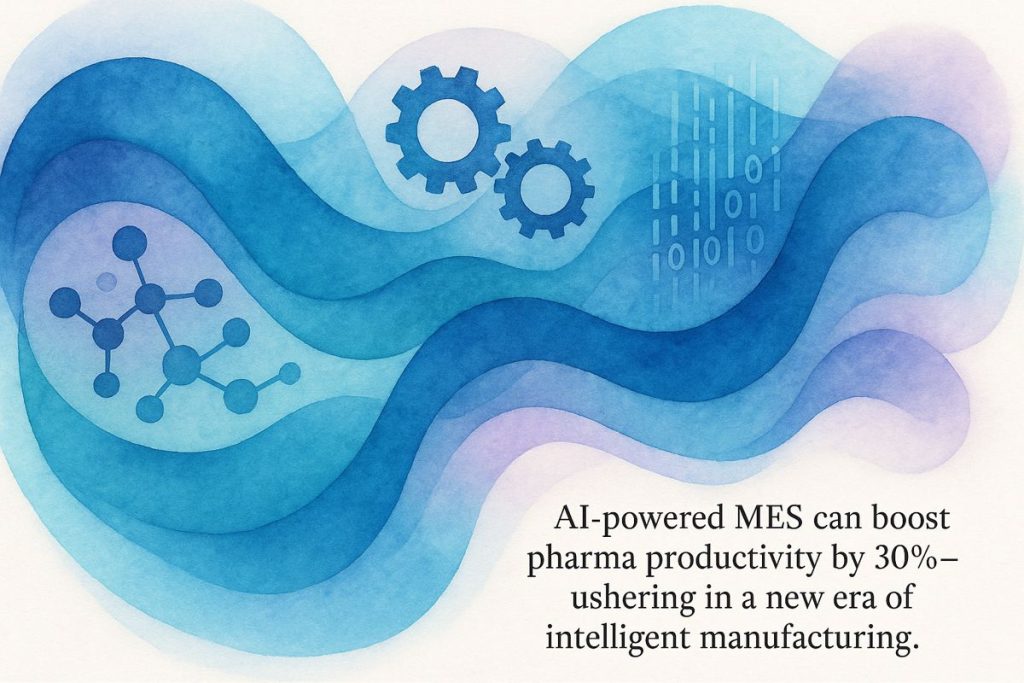Generative AI is bringing a big change to manufacturing in pharma and life sciences. It helps spot problems faster, predicts when machines need fixing, and even suggests better ways to schedule batches. Operators can simply talk to the system and get answers quickly, making their jobs easier and reducing mistakes. With digital twins and smarter record-keeping, everything runs smoother, safer, and more efficiently.
What are the benefits of using generative AI in Manufacturing Execution Systems (MES) for pharma and life sciences?
Generative AI in MES for pharma and life sciences offers real-time anomaly detection, predictive maintenance, optimized batch scheduling, rapid root cause analysis, natural language interfaces for operators, digital twins for simulations, enhanced compliance documentation, and improved overall equipment effectiveness (OEE), leading to increased efficiency and reduced human error.
The Hum and Whir of a New Era
Step onto a modern pharmaceutical plant floor and you’ll hear a symphony—oscilloscopes humming, the sharp clack of a barcode scanner, the low mutter of operators in hairnets. For decades, Manufacturing Execution Systems (MES) have orchestrated this industrial music, keeping every note in time. But lately? I’ve had to stop and ask myself whether the conductor’s baton is subtly changing hands.
Traditional MES platforms—think Siemens Opcenter or Emerson Syncade—once relished their roles as digital clipboards: tracking, controlling, ensuring compliance. Yet, as generative AI tiptoes in, we’re witnessing an almost Copernican shift. Now, the software doesn’t just record what happens; it whispers suggestions, flags patterns, and sometimes anticipates what’s coming next. If that sounds like science fiction, well, last week I watched an AI agent flag a potential deviation minutes before a seasoned operator even furrowed his brow. The future, it seems, smells faintly of ozone and possibility.
From Rote to Responsive: How AI Recalibrates MES
Let’s get granular. MES used to be rigid—more bureaucrat than savant. Generative AI is the caffeine shot it never knew it needed. Armed with hyperspectral data feeds (yes, actual wavelengths beyond just temperature and pressure), AI agents now parse multi-gigabyte process logs in milliseconds, surfacing anomalies that might have slipped by unnoticed until a batch failed inspection. One pharmaceutical facility I visited had an incident—call it a micro-drama—where a sticky valve’s sluggishness was detected by an AI agent parsing vibration data, leading to a fix before the next batch ran. The old routine? Wait for the alarm, scramble, and pray you hadn’t lost $250k in product.
But there’s more. These AI-augmented MES platforms aren’t just reactive—they’re simile-slinging strategists, suggesting batch schedules that flex like yoga instructors during supply chain crunches or instrument hiccups. Imagine a digital twin—say, built with Dassault Systèmes’ DELMIA—running a thousand “what-if” scenarios while you sip your lukewarm latte, giving you a menu of contingency plans before the real world even blinks. If that isn’t a palimpsest of old and new, I don’t know what is.
Analytics, Agents, and the Limits of My Patience
I’ll admit, I was skeptical when predictive maintenance claims first buzzed across my desk. (Burned once by an overhyped dashboard, twice shy.) But after reading a McKinsey report on how generative AI boosted Overall Equipment Effectiveness (OEE) by 10–15% in labyrinthine drug plants, and seeing a real-time dashboard in action, I felt a twinge of—dare I say it—hope. These agents mine equipment logs, sniff out subtle vibrations or pressure irregularities, and ping maintenance crews before a “thunk” turns into an “ugh.”
Even in root cause analysis, generative AI has become a kind of digital Sherlock. Instead of poring over batch logs for hours, the system cross-references deviations with historical data, quality events, and environmental records in seconds. I’ve seen it pinpoint a faulty gasket—down to the batch number—before the morning shift even clocked in. That’s not just efficiency; that’s a glimmer of pride for teams long buried in paperwork.
Natural Language, Unnatural Speed
Here’s where it gets wild: Operators now talk to MES like they’re chatting with a barista. Natural language interfaces, powered by LLMs like OpenAI’s GPT-4, let a technician ask, “What’s causing the pressure dip on Reactor 4?”—and get an answer that’s less opaque than a bowl of borscht. Some plants report a 60% cut in onboarding time for new recruits. That’s the kind of productivity boost that actually gets noticed—especially when you’re short-staffed and regulatory audits are looming like the Sword of Damocles.
The co-pilot concept—a digital assistant perched on your shoulder, feeding context-aware tips or just-in-time documentation—has gone from slideware to daily reality. Instead of sifting through arcane menus, an OEE analyst can ask, “Show me last month’s deviation trends by shift,” and see a chart before the coffee’s even cooled. I’m still a little wary: sometimes, the AI’s tone is too chipper, like it hasn’t yet tasted a true production disaster. But I suppose we all start out that way.
Digital Twins, Digital Confidence
Digital twins—virtual doppelgängers of production lines—are no longer just PowerPoint fodder. When integrated with AI-powered MES, they’re transforming how pharma outfits (think Roche or Novartis) test process tweaks or simulate equipment failures. During a recent project, I watched a process engineer tweak parameters in a digital twin, watching virtual batches ripple through the model in a ballet of cause and effect. The result? Fewer pilot runs, faster troubleshooting, and a sense of calm that even the best coffee can’t mimic.
Compliance, of course, is the ever-present specter. With generative AI, documentation practically writes itself—batch records and audit trails spun to FDA or ISO specs with a granularity that would make an auditor blush. Human error shrinks, and the muddy fingerprints of manual entry fade into the background. As someone who’s sweated through more than one inspection, that’s a relief bordering on joy.
Modular, Vendor-Agnostic—and Human
What’s especially promising: vendor-agnostic, modular MES platforms. They’re breaking the old
